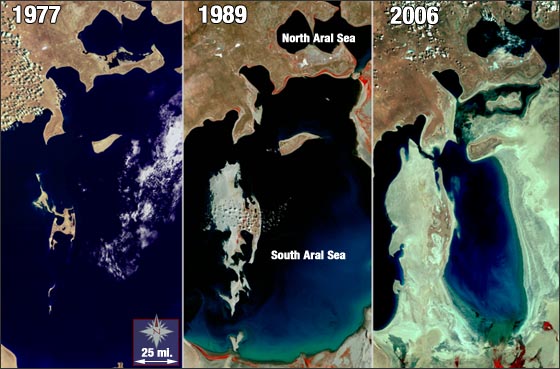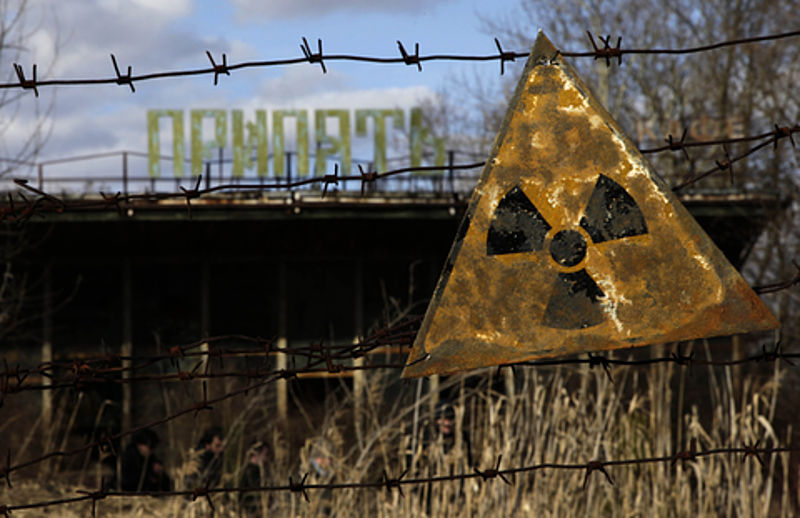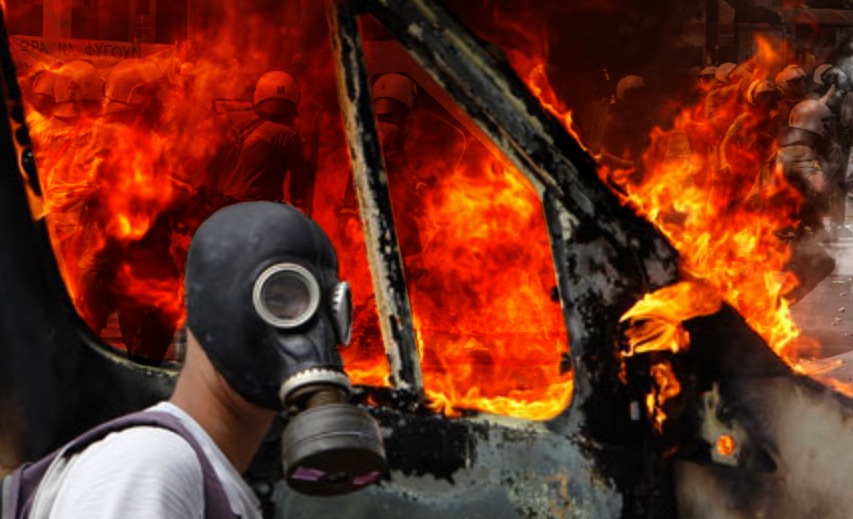Capitalism gets a bad rap when it comes to environmental issues. And yet, when you look at the most polluted areas of the world, what’s the one thing they all have in common? Socialism!
#1. Where socialism thrives, the environment dies.

Time Magazine produced a report in 2009 which listed the world’s 10 most polluted cities. They were:
- Kabwe, Zambia
- Sumgayit, Azerbaijan
- Norilsk, Russia
- Dzerzhinsk, Russia
- La Oroya, Peru
- Sukinda, India
- Tianying, China
- Linfen, China
- Chernobyl, Ukraine
- Vapi, India
Guess what all these cities have in common? Yup! They’re all in currently or formerly socialist countries.
#2. The Story of the Aral Sea

The Aral sea, really the world’s 4th largest lake, covered 25,000 square miles of territory bordering on Uzbekistan and Kazakhstan. In the early part of the 19th century, both nations became a part of the Soviet Socialist Republic, and underwent massive industrialization coordinated by the government.
The USSR went to work channelling the rivers away from the lake, until the 1960’s when the once massive body of water was split into three separate lakes, one of which disappeared, and another which has almost totally gone away. The water equivalent of Lake Huron and Lake Erie was lost. It’s widely considered one of the worst ecological disasters in all of human history.
And that’s not all! What’s leftover from the disaster is a cesspool of poison. The mineral salts and toxins in the sediment stir up in the dust, get into people’s lungs, contaminating humans and spreading contaminated dirt. Industrial projects were given free reign BY THE GOVERNMENT to pour runoff into the lake, spreading toxins into the sediment which are now exposed to the population. The rapidly eroding soil has contributed to desertification of nearby areas as well.
The truly sad part of this story is that this wasn’t an accident. It was planned destruction by the government, and all of the communities who depended on the water source whose livelihoods were destroyed were just seen as a necessary sacrifice on the altar of socialism.
#3. Chernobyl

Although it’s a great map to play on Call of Duty, it’s one hell of a dirty place to live, for obvious reasons. Widely considered one of the greatest environmental disasters in history, the meltdown of the nuclear reactor at Chernobyl had a devastating impact that is still being felt today. The central planners of the nuclear plant had no personal incentive to be careful, after all, who cares when it’s a government project anyway? We don’t take ownership, so where is the incentive to protect your property?
The explosion at the Chernobyl nuclear plant spread dangerous radiation over much of the Western USSR and Europe. It’s classified as a level 7 event, the maximum classification, with the only other one on that level being the Fukushima nuclear disaster, which of course was not human caused. The crisis in Chernobyl marked the beginning of the end of Soviet socialism, paving the way for glasnost, and the reforms which would eventually lead to the collapse of the USSR.
#4. Dirty Socialist Oil Companies

When BP spills oil into the Gulf of Mexico, the president remarked that he knows whose “ass to kick.” But what happens when the people who own the oil company are the government?
Pemex is the second largest oil company in the world, and it’s almost wholly owned the the Mexican government. The operations are fully controlled by the government, however. In 1979, an explosion at the Ixtoc well caused what was at the time the largest oil spill in history. In 1984, Pemex caused an explosion which killed more than 500 people. 200 more died in explosions in Guadalajara in 1992. Their safety record is pretty abysmal.
Also, the Pemex company has a terrible track record of dumping hazardous waste into the Coatzacoalcos River, wiping out the fish population and devastating the local fishing communities. One fisherman said of the disaster, “You cut the fish open and a smell like ammonia comes out. If you eat it, your stomach swells like a balloon.”
The pollution in the river by Pemex is so heinous that the river has been known to catch fire from time to time. The groundwater damages crops, and harms farmer’s ability to maintain livestock. Still, the profits that the government gets from controlling the company are too great for them to give it up and allow private ownership and accountability to come into play.
#5. Nuke em all, there’s no god to sort em out.

The Soviet Union conducted hundreds of dubious nuclear explosion tests across the country. One site, the Semipalatinsk Test Site in eastern Kazakhstan conducted 456 tests between 1949 and 1989. In 1991 the site was officially closed and ordered that compensation be given to those who had been struck ill from the radiation leaks.
The socialist government was at least kind enough to provide breast cancer screenings to 18,000 women who lived in areas near the test site. Gulsum Kakimzhanova, head of the nongovernmental organization Iris, which is based in Semipalatinsk, arranged for the screenings. Her own family were affected by the tests. “One morning when I was a small girl, my father awoke to find all of his hair had fallen off onto his pillow overnight, “Kakimzhanova said. “Only many years later, when I began working on health issues as a trained biologist, did I realize that my father’s hair loss was likely caused by radiation exposure while he labored outside as a railway worker near the test site.”
From The Bulletin.org:
The actual extent of damage inflicted by nuclear testing at Semipalatinsk continues to be the subject of much research and debate. A 2008 study by Kazakh and Japanese doctors noted that the population in Semipalatinsk and other areas adjacent to the test site received more than 500 millisieverts of radiation in one exposure.1 In one village, which was engulfed by a radioactive cloud after that first nuclear test in August 1949, 90 percent of its inhabitants received an external effective dose of up to 1,400 millisieverts during the first year alone. (See “Radiological Situation in the Vicinity of Semipalatinsk Nuclear Test Site”.) In the most heavily contaminated areas, people received an estimated effective equivalent dose of 2,000 millisieverts during the years of testing. (See “The Semipalatinsk Nuclear Test Site: A First Analysis of Solid Cancer Incidence [Selected Sites] Due to Test-Related Radiation”.) At the very least, a majority of the 220,000 affected people were exposed to an estimated dose of between 7 millisieverts and 350 millisieverts, and about 37,200 residents were exposed to radiation doses between 350 and 990 millisieverts during the period of atmospheric testing. (In terms of actual health effects, the Kazakh and Japanese scientists noted that the rate of cancer in those living in eastern Kazakhstan, the area most exposed to radiation, remains 25-30 percent higher than elsewhere in the country; they also reported a higher chance of mental deficiencies in children born to parents who were exposed to radioactive fallout from testing.
#6. Socialism isn’t Gorges

The Three Gorges Dam of Communist China is another one of the world’s greatest ecological disasters. After decades of construction, it was finally completed in 2012… with the original proposal made in 1944. When communists took over in 1949, the Great Leap Forward (which killed millions of people) slowed the project’s forward progress considerably.
Although the Chinese government looks at the dam as a great success, it is inarguably damaging the environment, and increasing the instances of landslides. Millions of people have been forced to relocate due to the damage caused by the project, and several historic archaeological sites were totally destroyed by flooding. Algae blooms are spreading, riverbank collapses and landslides are common.
Huang Xuebin, a senior engineer on the project admitted that “Regular geological disasters are a severe threat to the lives of residents around the dam.” Experts have warned that the pollution and sediment buildup is causing algae buildup in local rivers. The percentage of forested area in the region surrounding the Three Gorges Dam has dropped from twenty percent in 1950 to less than ten percent as of 2002.
The famous Chinese river Dolphin, the Baiji, is now extinct, many argue because of the dam project. But we thought socialists cared about protecting the little animals? Apparently not.
#7. Dirty Commies
During the Cold War, the split of Germany between the Allied countries was a sad testimony to the divide between East and West. Still, it was an interesting case study for how East and West Germany’s capitalist and communist governments would handle the environment. Guess which one was cleaner? The capitalist West of course!
When Germany was finally reunified, it was found that approximately 42% of moving water and 24% of still waters were so polluted that they could not be used for drinking water.
Marc Fisher of the Washington Post described the scene in the town of Bitterfield during a visit in 1990.
“Here, rivers flow red from steel mill waste, drinking water contains many times the European Community standards for heavy metals and other pollutants, and the air has killed so many trees — 75 percent in the Bitterfeld area — that even the most ambitious clean-up efforts now being planned would not reverse the damage. East Germany fills the air with sulfur dioxide at almost five times the West German rate and more than twice the Polish rate, according to a recent study. One chemical plant near here dumps 44 pounds of mercury into the Saale river each day — 10 times as much as the West German chemical company BASF pumps into the Rhine each year.”
Marlise Simons of the New York Times wrote of the situation in Bitterfield that “[t]he air stings, and the water in brooks and rivers has turned to syrup[.]” During communist rule, the town had a guest house which featured gas masks in the lobby. They would reportedly send their children to the coast or mountains for a month every year to give their lungs a break.
So what are we to glean out of all this? That when people don’t own the means of production, they have no incentives to protect the environment! After all, in a capitalist society, if there’s an oil spill, we know whose asses to kick. But if the government owns the means of production, and they make a mistake, well, too bad! We’re all just experiments in the centrally planned socialist economy, and our deaths are just collateral damage in the quest to make a more perfectible society.





